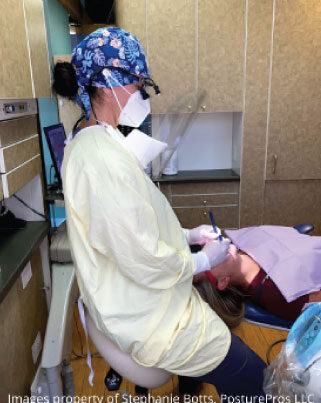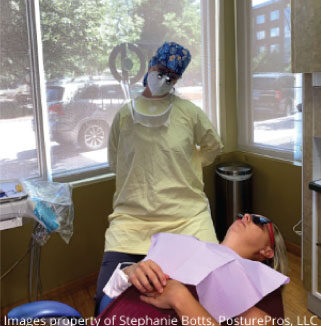
Stephanie Botts, RDH, BSDH, CEAS
Stephanie has been a full-time clinical dental hygienist for 13 years. She is a Certified Ergonomics Assessment Specialist providing both in-office and virtual ergonomics consulting and coaching to dental professionals. Her experience as a clinical dental hygienist and ergonomics expert has allowed her to recognize the unique challenges of practicing pain-free in the dental setting.
Adopting an ergonomic mindset is crucial in practicing dentistry. It allows us to respect and honor our body’s unique capabilities and limitations by adjusting our work environment to support us.
Our body is not meant to be hunched over for hours a day, with little time to rest and recover. Our necks are not designed to be constantly pushed forward and down, which throws the entire spinal curve into disarray.
We shouldn’t have to work in and through pain and have a reduced quality of life due to our jobs. As an ergonomics coach for dental professionals, I have noticed some common ways clinicians can practice safer and more ergonomically, and in this post, we will cover five of these.
1. Mindset
Like in so many other areas of life, mindset is key! Having an ergonomic mindset is not only about standing up straight, it's about putting ourselves first before even thinking to start on our patient. I try and encourage my clients to think, "How am I going to care for myself during this next hour? How do I want to feel later?"
Adopting this "I matter too" mindset helps us to remember to care for our bodies first and foremost.
The ergonomic mindset is also one of prevention. For example, in dentistry, we are significantly at risk for musculoskeletal disorders and early retirement due to injury and disability. Recognizing this will help us better care for our bodies, both in and outside the operatory.
2. Operator Positioning
Establishing proper operator positioning is also a key factor in trying to practice ergonomically. We must establish neutral posture first, then adjust the patient accordingly. This looks like adjusting our stool, rolling our shoulders back and down, pushing the chin back, and keeping the arms close to our sides.
For most clinicians, doing most of their work from the 11 o'clock to 1 o'clock position is safest. This position allows for minimal twisting and leaning, and will help support a more neutral working posture.
Also, being "squared up" to whatever area or tooth you are working on is the best practice. It allows the working area to be perpendicular to your line of sight (either using direct or indirect vision) and will support the body being upright and in balance.
3. Patient Positioning
Less-than-ideal patient positioning is something I see so often when working with clients. In supporting our neutral posture, the patient must be reclined back far enough. The goal is to have the patient's oral cavity at the elbow or waist level. When the patient's mouth is above this level, we are forced to raise and abduct our arms while usually leaning to one side.
This awkward posture places incredible strain on the musculoskeletal system and will lead to fatigue and possible injury over time.
We can also involve our patients when trying to position them correctly. It is perfectly acceptable, I promise, to ask our patients to move their heads from side to side or up and down to better position them for treatment. It seems that we would rather stand upside down than ask our patients to move an inch, but it will help ensure neutral posture.
4. Stretching
We have all heard that stretching is crucial for us, and with good reason. Stretching allows vital blood, oxygen and nutrients to flow into overworked muscles, repairing the damage we have done while contracting them.
Stretching both before and after work is essential for us, much like an athlete's warm-up and cool-down period. In addition, stretching during the day has been shown to reduce pain and fatigue in dental professionals.
Daytime stretching looks like taking microbreaks in the operatory every 20 minutes or so to stretch anything out for 20-30 seconds. Our schedules are typically packed to the brim, but there are typically small moments during an appointment where a stretch can be incorporated if one looks close enough.
5. Equipment Choices
Selecting the proper ergonomic equipment can make or break, sometimes literally, the career of the dental clinician. Ergonomic dental stools, correctly chosen and adjusted to each practitioner, have been shown to support a neutral working posture.
Loupes and a headlamp have also made many clinicians’ lives more manageable in the operatory. Using ergonomic gloves, either ambidextrous or hand-specific, has been shown to help with hand fatigue and pain. Also, various changes in instrument design help to reduce fatigue and pinch force for clinicians.
Practicing dentistry is challenging, no doubt about it. We have schedules to keep, patients to care for, and team members to support. And while there are some things about our jobs we cannot change, there are plenty of minor adjustments we can make to better care for ourselves and ensure a long and healthy career.
Stephanie is a Certified Ergonomics Assessment Specialist providing both in-office and virtual ergonomics consulting and coaching to dental professionals. She can be contacted by email at stephanie@posturepros.net, through her website at www.posturepros.net, or by phone at 907-229-4989.



Submit a Comment